Abstract
The article considers the issue of the importance of cross-cultural competence of the subjects of the educational environment. It examines the social and cultural, as well as language barriers in cross-cultural situations, determines the difficulties experienced by the communicants and their preparedness level to communicative interaction. Authors note that the cross-cultural situation occurs not only in communication of the representatives of different nationalities, but also when teachers communicate with children of migrants, with students of different religions, with children with special educational needs. The article presents the results of a survey of students of the Mari State University concerning their readiness for communicative interaction in the conditions of a cross-cultural situation. The university has students of the Mari, Russian, Tatar, Chuvash, Georgian, Armenian, Chechen, Udmurt, Bashkir and other nationalities, as well as foreign students from India, Tajikistan, Turkmenistan, Egypt, Hungary, Finland, and other countries. All of them practice different religions (Christianity, Islam, Buddhism, Hinduism, Paganism, etc.), they are guided by their own rules of communication and adhere to their values. The results of the survey show that the main and first difficulty for foreign students is the language barrier when they come to study in the other country. They also mention social and cultural differences, which render communicative interaction difficult. The article presents quantitative and qualitative indicators of high, medium and low levels of readiness for communicative interaction in a cross-cultural situation.
Keywords: Educational processcross-cultural situationinteractionethnic groupforeign students
Introduction
Modern educational space is characterized by a variety of cultures represented in it, which undoubtedly requires special communication skills from its subjects to establish interaction with their representatives, a kind of cross-cultural competence. Let us note at once that cross-cultural competence is most often associated with intercultural communication, and initially it was reduced to communication in a foreign language.
The aim of our study is to determine the difficulties experienced by communicants in conditions of a cross-cultural situation, and the level of their readiness for communicative interaction.
Problem Statement
At the moment, there are many studies that reveal the essential and meaningful characteristics of cross-cultural competence of managers, diplomats, business representatives. But there are not enough developments devoted to the analysis of cross-cultural competence of the subjects of the educational environment. And here it is necessary to speak not only about communication with the representatives of various ethnic cultures and confessions, but also about work in the conditions of inclusive practice. In accordance with the law "On Education in the Russian Federation" (The State Duma, 2012) equal access to education should be provided to all categories of students, taking into account the diversity of special educational needs and individual possibilities. In accordance with this, one of the most important "professional competences of a teacher working in conditions of inclusive education is a communicative competence, which allows effective interaction with students with disabilities and creating conditions for their cooperation with the surrounding society" ( Zinova & Shaydullina, 2014, p. 2).
Research Questions
The question is how ready both teachers and students to accept cultural differences and tolerant attitude to a "different person", and what to do to reduce the impact of social and cultural barriers during communication. Let us analyze the situation on the example of the territory of the Mari El Republic which is characterized by polyethnic and polyconfessional nature. The Republic includes the inhabitants of more than 110 nationalities (Mari, Russians, Tatars, Chuvash, Ukrainians, Udmurts, Armenians, Azerbaijanis, Uzbeks, Arabs, Indians, etc.), 151 religious organizations of different faiths (Russian Orthodox Church, old believers, Mari traditional religion, Islam, Buddhism, Judaism, etc.). According to the Ministry of Education and Science of the Mari El Republic in 2017-2018 academic year, 2245 children with disabilities attend preschool organizations, 2985 children with disabilities studied in general educational institutions, including 1822 children with mental retardation.
Purpose of the Study
We can say that the educational process includes the cross-cultural situation when teachers communicate with children of migrants, with students of different religions, with children with special educational needs.
Research Methods
Updating of the problem of cross-cultural interaction is associated with low tolerance of the Russian population. It is presented in the study of Rybakovskiy ( 1996) and others.
Meanwhile, the expansion of migration processes and the weakening of public attention to the problem of multicultural education, observed in recent years, have led to the increased intercultural tension. The most important mechanism for supporting tolerant relations between the subjects of the educational process is the development of their communication skills when they receive full and reliable knowledge about the culture, customs and traditions of different ethnic and social groups, which will help to overcome xenophobia and negative stereotypes, form attitudes to consent and cooperation, respect for cultural differences.
The presence of certain inconsistencies in the relationship of a person with the surrounding world (for example, with the ethnic and cultural or religious environment) requires the adaptive efforts aimed at integration. Intercultural adaptation in a broad sense is understood as a complex process through which a person achieves conformity (compatibility) with the new cultural environment, as well as the result of this process (a sense of satisfaction and fullness of life, individual's participation in the social and cultural life of a new group). In the narrow sense it is understood as the process of entering into a new culture through gradual acquisition with its norms, values, images of human behavior. It is the level of cross-cultural competence of the personality that determines the success of intercultural adaptation and the efficiency of its communication.
The study of communicative competence, the analysis of its functions and structure was carried out by many researchers. Thus, Zhukov (2003) characterizes communicative competence as a metacompetence included in the social, professional, and interpersonal competence and which is a binder of these entities. The nature of communicative skills and abilities of a teacher was studied as well. In particular, Kan-Kalik and Nikandrov ( 1990) distinguishes the following communicative skills of a teacher: purposeful arrangement and management of communication, communication in public, organization of students' creative activity, etc. In their research on the problem of intercultural communication Zimnyaya ( 2003) consider the key competences from the point of view of the efficiency of education (special, ethical, aesthetic, cultural). A study of intercultural communicative competence and the development of trainings of intercultural communication is another important aspect. The essence and structure of cross-cultural competence was studied by Lebedeva ( 2011) and others. Interpretations of this phenomenon were reduced to multicultural competence, diversity of cultures, cross-cultural efficiency, etc. It means the authors considered it as an integral quality of a personality, including knowledge about the features of different cultures, readiness and the ability to correctly perceive cross-cultural information, a positive attitude to communicate with the representatives of other cultures, a high level of empathy and interethnic tolerance.
In the world of science, first of all, it is necessary to note the merits of the American school, which has become since the second half of the twentieth century and is still the leader of scientific research on the theory and practice of intercultural communication. This is evidenced by a huge number of different kinds of textbooks written by American authors, including classic works by Rubin and Brown ( 2005).
How ready are the university students for communicative interaction in the conditions of a cross-cultural situation was checked on the basis of the Mari State University. The University has students of the Mari, Russian, Tatar, Chuvash, Georgian, Armenian, Chechen, Udmurt, Bashkir and other nationalities, as well as foreign students from India, Tajikistan, Turkmenistan, Egypt, Hungary, Finland, and other countries. All of them exercise different religions (Christianity, Islam, Buddhism, Hinduism, Paganism, etc.); they are guided by their own rules of communication and adhere to their values.
All this, one way or another, contributes to the creation of communication barriers between the representatives of different cultures, caused by the difference in the perception of reality, the system of values, stereotypes of communication and behavior, etc. In this case educational institutions need the qualified help of scientists in the field of linguistics and teaching skills ( Fahrutdinova, Bulatbayeva, Kondratova, Fedorova, & Petukhova, 2018). Communication barriers are considered as psychological or social and cultural barriers that occur during communication. Let us consider the communicative barriers of university students in the conditions of a cross-cultural situation.
The used research methods included focus groups with Russian and foreign students, participant observation, interviewing, testing; the purpose was to identify the difficulties experienced by them in the process of communicative interaction in the conditions of a cross-cultural situation.
The participants of a survey were Russian and foreign students from near- and far-abroad countries. In total, 46 Russian and 75 foreign 1-year students of the Medicine Faculty of the Mari State University took part in the survey.
Findings
The results of the survey of Russian and foreign students are presented in the form of tables, bar charts and pie charts. Let us start with the results of a survey of Russian students.
To the question: "What is your attitude to the foreign students?" they gave the following answers (Table
The results presented in the table show that the majority of Russian respondents (21 people) expressed respect for foreign students, friendliness, willingness to help, interest in meeting new people. 17 people are neutral, the rest are somewhat alerted by their noisy behavior.
We have also observed the willingness of Russian students to help. The results are presented in Table
The results of answers of Russian students to the question whether they approve the arrival of students from other countries to study at the Mari State University are presented in Figure
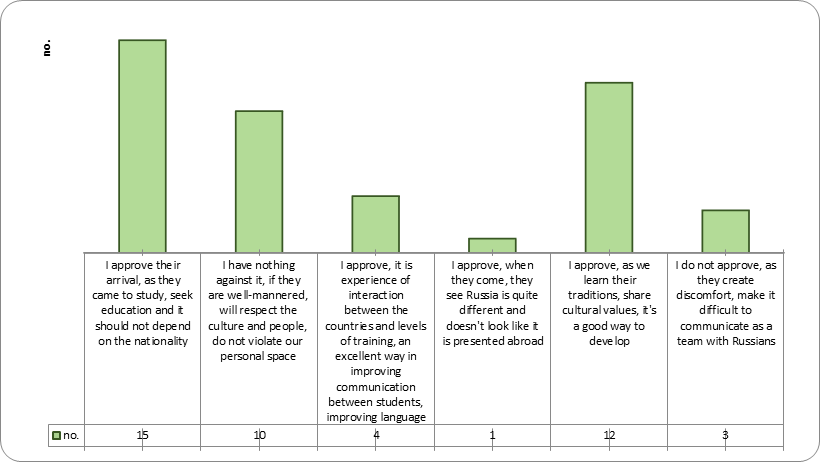
42 people approve the arrival of students from other countries to study at the university, noting that they came to study, to seek education and it should not depend on nationality. In addition, it is a great way to improve communication between students, improve language skills, and get acquainted with the traditions and cultural values of other nations.
Russian students were asked about the conflicts with foreign students (Figure
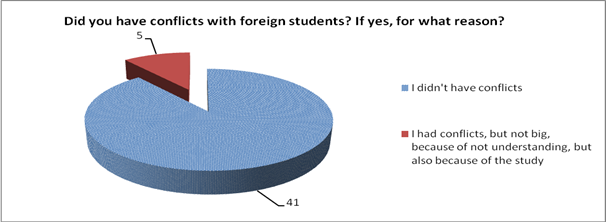
It is pleasant to note that 41 people did not have any conflicts with foreign students and only 5 people noted that they had conflicts, but not serious, mainly because of a lack of language skills.
The next question that was asked to students: "How do you feel about spending their leisure time with people of a different culture?" (Table
The results showed that 35 people have a positive attitude to spending their leisure time with people of other cultures; they note that it is possible to talk with them on different topics, compare countries, traditions, and it is interesting. But 22 people underlined that it is important that no one shall praise their culture over others, touch upon issues of nationality and religion.
Figure
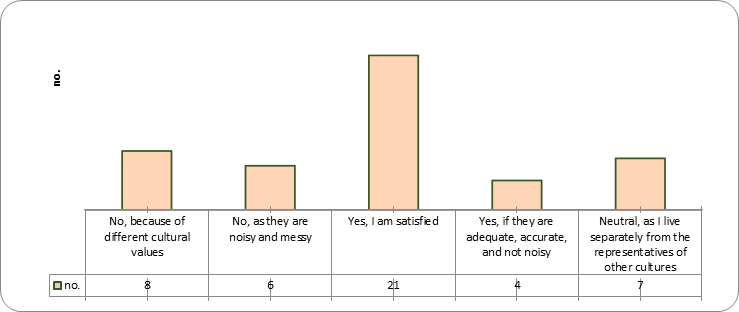
The results show that 25 people are satisfied with living close to the representatives of other cultures. 7 people are neutral on this question, as they live separately, and 14 people noted that such neighbourhood does not satisfy them because of different cultural values and because such neighbours can be noisy and messy.
Russian students were asked about the easiness to establish contacts with the representatives of other cultures (Figure
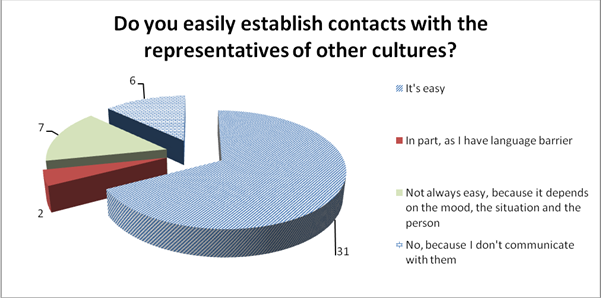
It turned out that it is easy for 6 people to establish contacts with the representatives of other cultures. 9 people noted that the language barrier, the specific situation and the cultural characteristics of the communicant prevent them from establishing contacts quickly.
Now let us analyze the answers of foreign students. The first question they were asked was about the difficulties they had experienced when they arrived in the Mari El Republic. The results of the answers to this question are presented in Table
Among the difficulties that foreign students faced when they arrived in the Mari El Republic, 13 people noted that it was difficult for them to get used to the new city, to the climate, to the time difference, and it was difficult to be far from their parents' home. 2 people had difficulties in communication, associated with ignorance of the Russian language. 52 people did not experience any difficulties.
Then we asked what difficulties they still have. It turned out that 38 people did not experience any difficulties at the moment. 9 people still had difficulties in speaking Russian, 24 people had difficulties in learning.The harsh climate and the weather were stressed out by 2 people.
The answers to the question about the assessment of people living in the Republic are interesting (Figure
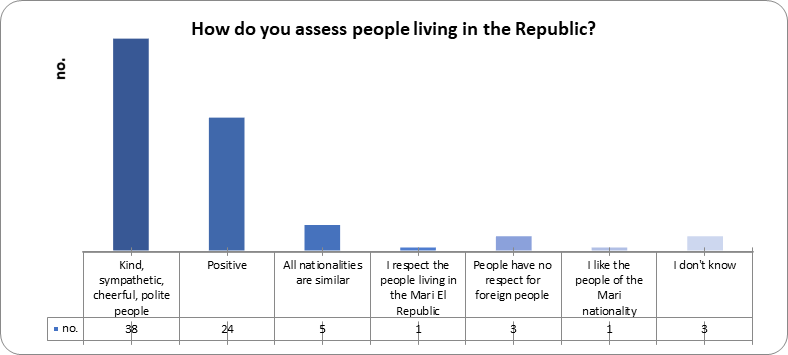
Foreign students were also asked about their relations with teachers (Figure
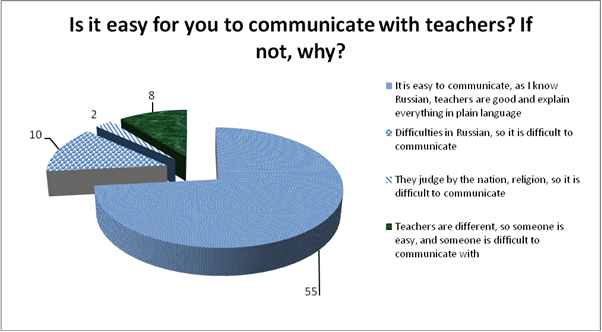
Regarding communication with Russian groupmates (Table
Foreign students were also asked about the difficulties they face when living in a dormitory with the representatives of other cultures (Table
The results presented in the diagram show that 64 people did not experience any difficulties when living in a dormitory with the representatives of other cultures, 4 people received comments from the representatives of other nationalities and 6 people did not like living conditions in the dormitory.
The results of the answers to the question about conflicts with other nationalities are presented in Figure
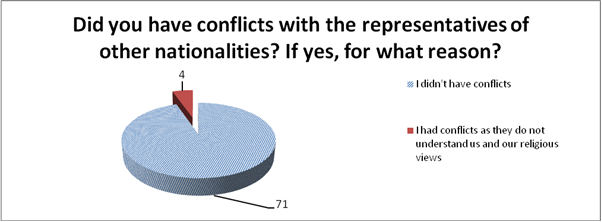
71 people had no conflicts with the representatives of other nationalities. 4 people noted that the conflicts were due to lack of understanding of religious views.
The results of the answers of Russian and foreign students to the question about the knowledge of etiquette norms and rules of behavior of the representatives of other cultures are presented in Table
The knowledge of the norms and rules of behavior of the representatives of other cultures noted 36 Russian students, assessing them well and perceiving positively. 10 people were not interested in them, as they use common norms and rules. 56 foreign students know etiquette norms and rules of behavior of the representatives of other cultures, they evaluate them positively, respect each culture, nationality and their traditions. 16 people did not know the rules, but they would like to get acquainted with etiquette norms and rules of behavior of other cultures. 2 people note that everyone had the right to have their cultural traditions and beliefs.
Thus, the results of the survey showed that the main and first difficulty for foreign students is the language barrier experienced by them when they came to study in the other country. Some of them do not have a high enough level of English to communicate. And most of them do not speak Russian. Therefore, it is difficult for them to establish contacts with teachers, groupmates, learn training material, prepare for seminars, etc.
Many foreign students are surprised by the peculiarities of the behavior of Russian students, which is characterized by emotional greeting each other, hugs, loud shouting. This is unacceptable for some categories of Indian students, communicating with whom one should take into account their belonging to a particular cast, as among them there are the representatives of the elite of society, which cannot be touched at all. In order to avoid misunderstanding and conflict situations it is necessary to exclude tactile interaction (slap on a shoulder, friendly hugs, kisses, etc.) from communication with them.
There are also social and cultural differences, which render communicative interaction difficult. Thus, Russian students living in the dormitory are annoyed by the habit of foreign students to start cooking their own food after midnight, when according to the rules of the dormitory everybody shall sleep without disturbing others. They consider peculiar smell of the prepared national dishes unpleasant. They reproach foreign students for dirtiness, violation of order, rules of residence in the dormitory.
Conclusion
Summarizing all the materials obtained by different methods, we can note that 10 % of the students surveyed showed the low level of readiness for communicative interaction in the conditions of a cross-cultural situation, characterized by inability to establish contacts with the representatives of different cultures, avoidance of communication with them, ignorance of language and etiquette norms, high propensity towards conflicts, and inability to find a solution in difficult communicative situations.
40% of the students showed the average level of preparedness to communicative interaction in the context of cross-cultural situation, characterized by difficulties in establishing contacts with the representatives of different cultures while having the desire to communicate with them, by problems with the knowledge of language and the rules of etiquette, restraint, or some propensity towards conflicts in difficult communication situations.
50 % of the students showed the high level of preparedness to communicative interaction in the context of cross-cultural situation, characterized by the ability to easily establish contacts with the representatives of different cultures, open-mindedness when communicating with them, the knowledge of language and the rules of etiquette, absence of propensity towards conflicts, the ability to quickly find solutions in difficult communicative situations.
In general, the results are good, but there are issues that should get special attention. There could only be one conclusion: readiness for communicative interaction in the conditions of a cross-cultural situation is formed as a result of systematic work with the student and by the student. And in this direction it is necessary to use a variety of forms of communication aimed at the development of tolerant characteristics of the subjects of the educational process.
Acknowledgments
The work is performed according to the Russian Government Program of Competitive Growth of Kazan Federal University.
References
- Fahrutdinova, G. Zh., Bulatbayeva, K. N., Kondratova, O. I., Fedorova, S. N., & Petukhova, O. A. (2018). Updating of language training content in Kazakhstan: implementation of new linguodidactic approaches. XLinguae Journal, 2, 239 – 255.
- Kan-Kalik, V. А., & Nikandrov, N. D. (1990). Creative Work in Teaching. Moscow: Pedagogika.
- Lebedeva, N. М. (2011). Ethnic and Cross-Cultural Psychology: textbook for Higher Educational Institutions. Moscow: MAX Press.
- Rubin, J. Z., & Brown B. R. (2005). The Social Psychology of Bargaining and Negotiation. Washington.
- Rybakovskiy, L. L. (1996). Russia and “New Abroad”: Migrational Exchange and its Influence on the Demographic Dynamics. Moscow: Institute of Socio-Political Research of the Russian Academy of Sciences.
- The State Duma. (2012, December 29). On Education in the Russian Federation. Retrieved from http://www.consultant.ru/document/cons_doc_LAW_140174/
- Zhukov, Yu. М. (2003). Communicative Training. Moscow: Gardariki.
- Zimnyaya, I. А. (2003). Key Social Competences – New Paradigm in the Results of Education. Vyssheeobrazovaniye v Rossii, 5, 15-20.
- Zinova, I. М., & Shaydullina, G. F. (2014). Communicative Competence of Teachers in Conditions of Transition to the Inclusive Education. Fundamental research, 8(4), 961– 965.
Copyright information

This work is licensed under a Creative Commons Attribution-NonCommercial-NoDerivatives 4.0 International License.
About this article
Publication Date
23 January 2020
Article Doi
eBook ISBN
978-1-80296-077-8
Publisher
European Publisher
Volume
78
Print ISBN (optional)
-
Edition Number
1st Edition
Pages
1-838
Subjects
Teacher, teacher training, teaching skills, teaching techniques
Cite this article as:
Vorontsova, E. M., Fedorova, S. N., & Fahrutdinova*, G. Z. (2020). Communicative Interaction In A Cross-Cultural Situation. In R. Valeeva (Ed.), Teacher Education- IFTE 2019, vol 78. European Proceedings of Social and Behavioural Sciences (pp. 629-639). European Publisher. https://doi.org/10.15405/epsbs.2020.01.69
